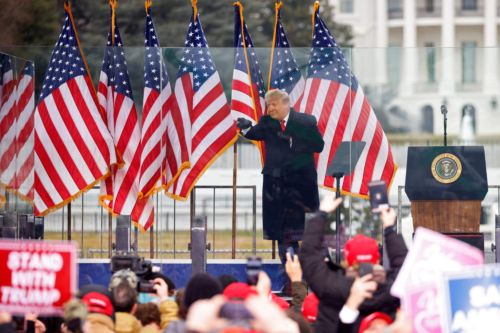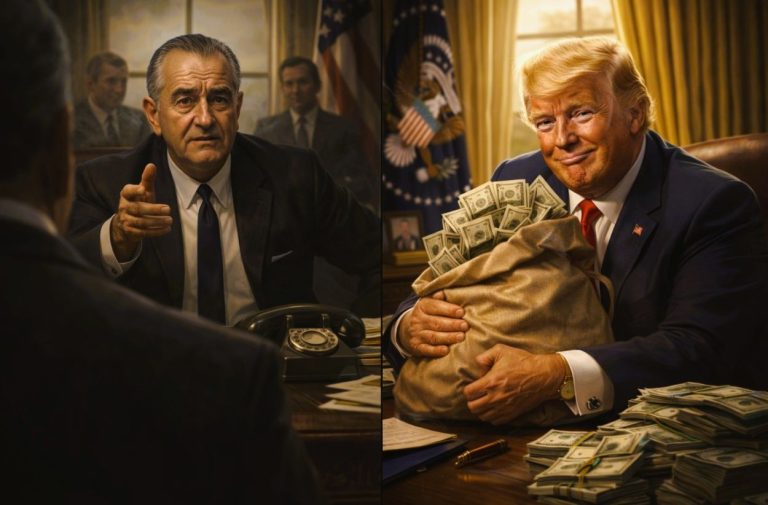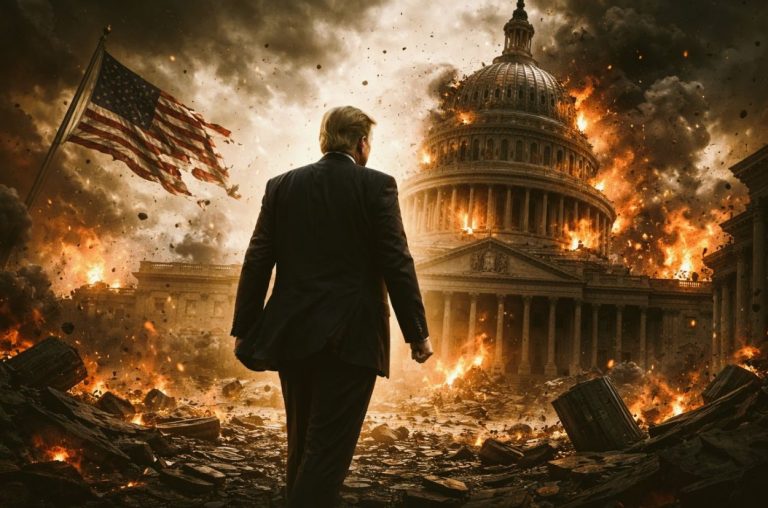

The record is difficult to ignore: from the nation’s capital to local school board meetings, the anger he helped unleash has repeatedly spilled over into threats, assaults, and bloodshed.

By Matthew A. McIntosh
Public Historian
Brewminate
Introduction
On the morning of January 6, 2021, thousands of Trump supporters surged past police barricades and into the U.S. Capitol, smashing windows, chanting threats, and halting the certification of a presidential election. Fueled by weeks of false claims of fraud and Trump’s final call to “fight like hell,” the attack left five people dead, injured scores of officers, and marked one of the darkest days in modern American democracy.
That siege was not an isolated outburst. From a thwarted kidnapping plot against Michigan’s governor to pipe bombs mailed to Trump’s critics, violence tied to his supporters has surfaced again and again, sometimes directly encouraged, other times carried out independently under the banner of his movement. Together these episodes reveal how Trump’s rhetoric and the culture surrounding it have made political violence an unsettling feature of American public life.
Directly Encouraged Incidents
Few moments illustrate the link between Trump’s words and subsequent violence as starkly as the January 6 attack on the U.S. Capitol. Speaking to a crowd near the White House that morning, Trump repeated false claims of election fraud and urged his supporters to march on Congress with the warning that they would “have to fight like hell.” Within hours, the crowd overwhelmed law enforcement, broken into the Capitol, and forced lawmakers to flee. More than 1,200 people have since been charged in connection with the assault, with prosecutors describing many as acting explicitly on Trump’s words.
The Capitol riot was the most dramatic case, but not the only one. Months earlier, in the spring of 2020, Trump tweeted “LIBERATE MICHIGAN” as part of a string of posts attacking state-level COVID restrictions. That call came just weeks before federal authorities foiled a plot by armed extremists to kidnap Governor Gretchen Whitmer. Prosecutors later detailed how the men had cited Trump’s rhetoric as justification for their plans.
Election officials have also borne the brunt of his attacks. When Trump and his allies singled out workers like Ruby Freeman and Shaye Moss in Georgia, falsely accusing them of tampering with ballots, the two women received a flood of violent threats and harassment. Freeman described living in fear, forced from her home, after Trump mentioned her by name. Those threats never came in the form of a direct order, but they flourished in the environment he created.
Violence Without Direct Cues
Not all incidents of violence tied to Trump’s movement stemmed from his explicit instructions. Some emerged from a broader culture of extremism and grievance that his rhetoric helped stoke.
In August 2017, white nationalists gathered in Charlottesville, Virginia, for the so-called “Unite the Right” rally. The event ended in chaos when a man drove his car into a crowd of counter-protesters, killing Heather Heyer. Trump’s response, insisting there were “very fine people on both sides,” drew national condemnation and emboldened extremists who saw his words as tacit validation.
The following year, Cesar Sayoc, a Florida man who decorated his van with pro-Trump slogans, mailed pipe bombs to more than a dozen critics of the former president, including Barack Obama, Hillary Clinton, and CNN. While Trump had not directed such violence, prosecutors made clear that Sayoc was radicalized in part by conspiracy theories and anti-media rhetoric circulating in Trump’s orbit.
More recently, in October 2022, an intruder broke into the San Francisco home of then–House Speaker Nancy Pelosi and assaulted her husband with a hammer. The attacker echoed election-denial conspiracies that had taken root in Trump’s base. That same wave of threats has swept across school boards and statehouses, where armed protests and intimidation campaigns have become increasingly common.
Rhetorical Environment
What connects these incidents is not just the perpetrators’ political alignment but the language that shaped their worldview. From the start of his political rise, Trump has relied on provocative, combative speech that casts opponents as existential enemies. At campaign rallies, he told supporters to “knock the crap out of” protesters and mused that “Second Amendment people” might have ways to stop Hillary Clinton. Such remarks blurred the line between metaphor and call to arms, leaving space for extremists to interpret his words as license for violence.
This rhetoric did not exist in isolation. On social media platforms, Trump’s words were amplified, repeated, and weaponized, spreading conspiracies to millions in real time. False claims of a stolen election ricocheted through far-right forums, inspiring both organized groups and lone actors. Experts on political extremism note that even when Trump did not explicitly call for violence, his framing, portraying political opponents as traitors or threats, normalized hostility and made violence feel like a justified response to his followers.
Response and Consequences
The fallout from these incidents has been sweeping. More than 1,200 people have been charged in connection with the January 6 attack, with hundreds sentenced to prison terms ranging from a few months to more than two decades. Federal authorities continue to track militia groups and online extremist networks that trace their rise to Trump’s movement.
Election officials, once largely anonymous civil servants, now require security details in some states. The Justice Department has launched special task forces to investigate threats against poll workers and public officials, underscoring how violence has reshaped the day-to-day functioning of American democracy.
Law enforcement and intelligence agencies warn that the danger has not passed. The Department of Homeland Security has repeatedly flagged Trump’s false election claims as a persistent driver of extremist activity. Even as prosecutions mount, the climate of threats and intimidation lingers, leaving a chilling effect on those tasked with administering elections and shaping policy.
Conclusion
Trump has often denied responsibility for violence committed in his name, insisting his words were misinterpreted or that those who acted were “patriots” treated unfairly by the justice system. Yet the record is difficult to ignore: from the nation’s capital to local school board meetings, the anger he helped unleash has repeatedly spilled over into threats, assaults, and bloodshed.
What makes this pattern so stark is not only the violence itself but its normalization. A decade ago, armed extremists plotting to kidnap a governor or mobs storming Congress would have been unthinkable. Today, such episodes are folded into a political landscape where Trump remains a central figure, and where his most loyal followers continue to see confrontation, even force, as part of their cause. As the country looks toward future elections, experts warn that the culture of menace may outlast Trump’s presidency. The question now is not whether his rhetoric has inspired violence, the evidence is clear, but whether American democracy can withstand a political movement that so often accepts it as part of the bargain.
Originally published by Brewminate, 09.23.2025, under the terms of a Creative Commons Attribution-NonCommercial-NoDerivatives 4.0 International license.


